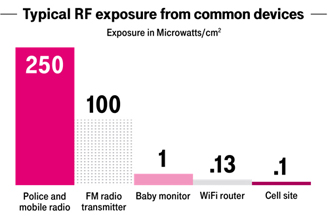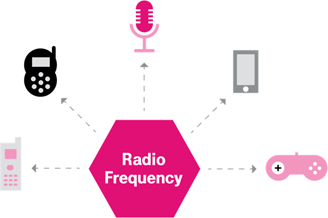
Radio waves and health
With so much information on the internet about how radio waves may impact our health it can be hard to know what to believe.
At T-Mobile, we make sure radio frequency (RF) emissions from our cell sites meet all requirements set by the Federal Communications Commission (FCC)—our license to provide wireless service depends on it.
When it comes to emissions and health, we look to the experts—including national and international organizations like the World Health Organization, American Cancer Society and
US Food & Drug Administration.

100 watts or less
Urban cell sites commonly emit an effective radiated power of <100w/channel. The FCC limit is 500w/channel.
Ongoing optimization
We monitor and optimize our cell sites 24 hours a day to ensure they are working properly and within FCC requirements.
Even though the FCC permits an effective radiated power (ERP) of up to 500 watts per channel, the majority of T-Mobile cell sites in urban and suburban areas operate at an ERP of 100 watts per channel or less.
What leading organizations say about RF exposure
THE NEW YORK TIMES
According to experts on the biological effects of electromagnetic radiation, radio waves become safer at higher frequencies, not more dangerous.
American Cancer Society
“Public exposure to radio waves from cell phone tower antennas is slight for several reasons. The power levels are relatively low, the antennas are mounted high above ground level, and the signals are transmitted intermittently, rather than constantly.”
cancer.orgThe World Health Organization
“Studies to date provide no indication that environmental exposure to RF fields, such as from base stations, increases the risk of cancer or any other disease.”
who.intU.S. Food & Drug Administration
“Available scientific evidence … shows no increased health risk due to radio frequency (RF) energy …”
fda.govHow radio waves work
Harnessing nature
Radio waves are created by harnessing naturally-occurring electromagnetic fields. All wireless communications travel via different bands of radio waves—also referred to as radio frequencies or spectrum.

A part of American history
Radio frequency (RF) is the same technology that has been used for radio broadcasts since the late 1800s. While RF lets us send and receive voice, text, photos, and videos with our phones, it’s also used by home electronics like baby monitors, cordless phones, and video game controllers.
Radio waves and public safety
Though some sites on the internet raise questions about whether radio waves are harmful, RF technology helps keep our communities safer by supporting essential public safety services, such as:
- 911 service, emergency and first responders
- AMBER and Silver alerts
- Natural and man-made disaster alerts
- Communication apps during and after disasters
- Reverse 911 Alerts

